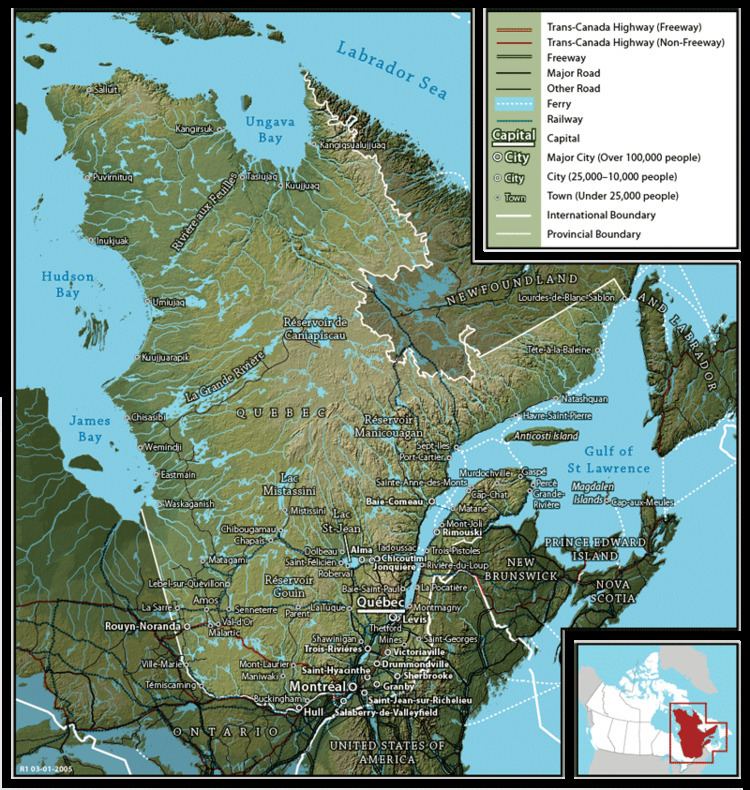J F M A M J | F M A M J J | |
 | ||
Quebec, Canada's largest province, occupies a vast territory (nearly three times the size of France), most of which is very sparsely populated. More than 90 percent of Quebec's area lies within the Canadian Shield, and includes the greater part of the Labrador Peninsula. Quebec's highest mountain is Mont D'Iberville, which is located on the border with Newfoundland and Labrador in the northeastern part of the province in the Torngat Mountains. The addition of parts of the vast and scarcely populated District of Ungava of the Northwest Territories between 1898 and 1912 gave the province its current form.
Contents
Quebec is bordered by the province of Ontario, James Bay and Hudson Bay (including the circular Nastapoka arc) to the west, the provinces of New Brunswick and Newfoundland and Labrador to the east, the United States (Maine, New Hampshire, Vermont and New York) to the south, and Hudson Strait and Ungava Bay to the north. Its northernmost point is Cape Wolstenholme.
In 1927, the border between the Province of Quebec and the Dominion of Newfoundland was delineated by the British Judicial Committee of the Privy Council. The government of Quebec does not officially recognize this boundary. See The Labrador boundary dispute.
The territory of Quebec is extremely rich in resources in its coniferous forests, lakes, and rivers—pulp and paper, lumber, and hydroelectricity are still some of the province's most important industries. The far north of the province, Nunavik, is subarctic or arctic and is mostly inhabited by Inuit.
The most populous region is the Saint Lawrence River valley in the south, where the capital, Quebec City, and the largest city, Montreal, are situated. North of Montreal are the Laurentians, a range of ancient mountains, and to the east are the Appalachian Mountains which extends into the Eastern Townships and Gaspésie regions. The Gaspé Peninsula juts into the Gulf of Saint Lawrence to the East. The Saint Lawrence River Valley is a fertile agricultural region, producing dairy products, fruit, vegetables, maple sugar (Quebec is the world's largest producer), and livestock.
In 1899, the United States claimed Fox Island under the Guano Islands Act of 1856.
Borders
Quebec shares a land border with four northeast states of the United States (Maine, New Hampshire, New York and Vermont) and with three other Canadian provinces (New Brunswick, Ontario and Newfoundland and Labrador). However, as said in the Etymology and boundary changes section, a border dispute remains regarding the ownership of Labrador. The border with Labrador is still not officially recognized by the Quebec Government. A maritime boundary also exists with the territories of Nunavut, Prince Edward Island and Nova Scotia. Quebec has officially more than 12,000 kilometres (7,500 mi) of borders of all types. Half of these are land limits, 12% river limits and 38% marine limits.
Geology
About a few thousand years ago, the area of southern Quebec was over the New England hotspot, creating the magma intrusions of the Monteregian Hills. These intrusive stocks have been variously interpreted as the feeder intrusions of long extinct volcanoes, which would have been active about 125 million years ago, or as intrusives that never breached the surface in volcanic activity.
Climate
Quebec has three main climate regions. Southern and western Quebec, including most of the major population centres, have a humid continental climate (Köppen climate classification Dfb) with warm, humid summers and long, cold winters. The main climatic influences are from western and northern Canada which move eastward and from the southern and central United States that move northward. Due to the influence of both storm systems from the core of North America and the Atlantic Ocean, precipitation is abundant throughout the year, with most areas receiving more than 1,000 mm (40 inches) of precipitation, including over 300 cm (120 inches) of snow in many areas. During the summer, severe weather patterns (such as tornadoes and severe thunderstorms) are far less common than in southern Ontario, although they occasionally occur.
Most of central Quebec has a subarctic climate (Köppen Dfc). Winters are long and among the coldest in eastern Canada, while summers are warm but very short due to the higher latitude and the greater influence of Arctic air masses. Precipitation is also somewhat less than farther south, except at some of the higher elevations.
The northern regions of Quebec have an arctic climate (Köppen ET), with very cold winters and short, much cooler summers. The primary influences in this region are the Arctic Ocean currents (such as the Labrador Current) and continental air masses from the High Arctic.
Environmental geography
The province is home to a wide variety of flora and fauna. The birdlife is diverse including Wild Turkey, Meleagris gallopavo, Yellow-bellied Sapsucker, Sphyrapicus varius and Loggerhead Shrike, Lanius ludovicianus.
